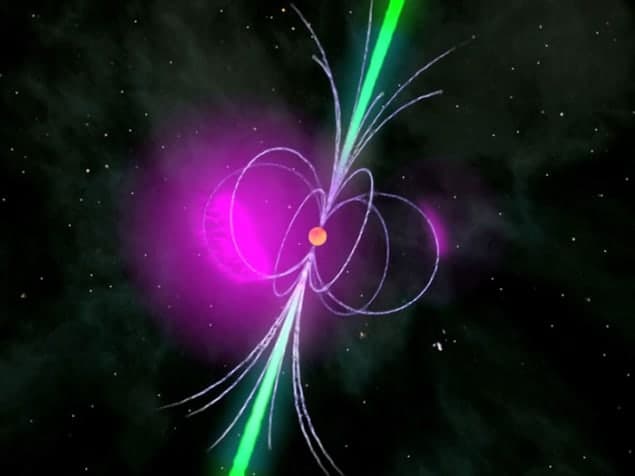Flash Physics is our daily pick of the latest need-to-know developments from the global physics community selected by Physics World‘s team of editors and reporters

Home computers help discover new pulsars
The Einstein@Home project has discovered 17 new gamma-ray pulsars within a sample of 118 unidentified pulsar-like sources. Tens of thousands of volunteers donated their idle computing time to help researchers analyse data from the Large Area Telescope (LAT) on board the Fermi spacecraft. Combined with newly improved search methods and Fermi-LAT data, an international team led by scientists at the Max Planck Institute for Gravitational Physics in Hannover has been able to identify 17 new pulsars. Pulsars result from extremely dense neutron stars that emit radio waves and gamma radiation because of their strong magnetic fields and fast rotation. When these beams point towards Earth as they rotate, they are seen as a pulse. However, detecting them is difficult and requires very fine resolution, years of data and huge amounts of computer power. The Einstein@Home project allowed the researchers to perform analysis within a year that would otherwise take more than a thousand years on a single computer. Thirteen of the new discoveries are presented in The Astrophysical Journal and the director of Einstein@Home, Bruce Allen, believes that many more could be pulsars in binary systems. Einstein@Home has also examined data related to gravitational waves and radio pulsars.
3D graphene could be stronger than steel
Researchers at the Massachusetts Institute of Technology (MIT) have proposed a new 3D graphene structure that if built could have 10 times the strength of steel with only 4.6% of the density. The team, led by Markus Buehler, has used bottom-up computational modelling and 3D-printed plastic models to investigate the mechanics of the proposed material and its unusual structure. Graphene is a 2D sheet of carbon atoms arranged hexagonally and is one of the strongest known materials. However, using it to create strong 3D structures is still a challenge. The MIT group did computer simulations from the atomic level to design the synthesis process, find the ideal structure and then understand its properties. The result was a 3D porous gyroid structure comprising compressed and fused graphene sheets. To help visualize the unusual structure, the team produced 3D-printed models and performed compression tests. The work is presented in Science Advances and the team says that if made, the 3D graphene could have many industrial applications.
SESAME synchrotron opens with first electron beam

The SESAME synchrotron-light facility in Jordan has circulated its first electron beam. Operated jointly by Bahrain, Cyprus, Egypt, Iran, Israel, Jordan, Pakistan, the Palestinian Authority and Turkey, SESAME is the only third-generation synchrotron in the Middle East. It will use the electron beam to create high-quality beams of laser-like light for research in a wide range of fields, including physics, materials science, chemistry, biology and archaeology. “This is a very proud moment for the entire SESAME community,” says the Jordanian nuclear engineer Khaled Toukan, who is the director of SESAME. “SESAME is now opening for business.” Next, SESAME staff will ensure that beam can be stored in the synchrotron ring at an operating energy of 2.5 GeV. Then, the light emitted by the electrons will be channelled into two beamlines and used by SESAME’s first experiments this summer.
- You can find all our daily Flash Physics posts in the website’s news section, as well as on Twitter and Facebook using #FlashPhysics. Tune in to physicsworld.com later today to read today’s extensive news story on an acoustic tractor beam.



